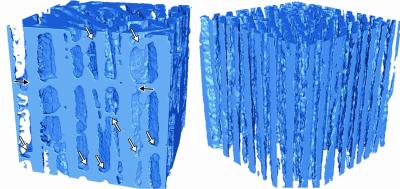- Home
- News
- General News
- Getting to grips...
Getting to grips with the freeze
20-11-2009
Winter is getting close and, with it, inevitably, icy roads and paths. Despite it being a common problem in cold weather, there is still no way to avoid it. This is mostly because scientists still don’t know exactly how particles move when they are being frozen. However, researchers from the Laboratoire de Synthese et Fonctionnalisation des Céramiques and the INSA Lyon (France) recently published some results that have moved a step closer to visualising the mechanisms of soils freezing in winter, among others.
Share
Freezing often involves the propagation of a solidification interface and its encounter with particles, microorganisms or bubbles in a liquid. Until today, studies have limited themselves in just considering a single particle in front of a flat interface propagating at low velocity. Other parameters need to be taken into account in order to get a realistic picture of the phenomenon: the speed of propagation can be much faster, on a non-flat interface and there are multiple particles interacting.
 |
|
Structure of ice crystals in the presence (left) or in the absence (right) of jumps in the interface. The arrows indicate future defects in the structure. |
Researchers tackled the challenge using X-ray imaging on the ID19 beamline at the ESRF. By freezing a concentrated suspension of ceramic particles, the researchers were able to observe in situ the growth of ice crystals and the movement of particles during freezing. They then obtained a three-dimensional image of the ice crystals after freezing by exploiting the differences in X-ray absorption between the ice and the particles. The researchers were then able to demonstrate that, under certain conditions, the interface “jumps”, accelerating in a punctuated manner and modifying the redistribution of particles and the growth of crystals. Sylvain Deville, main author of the work, explains this happens “because the interface returns to the equilibrium state when it is given enough time to do so, which is extremely interesting to materials science researchers. This work is a follow-up of a publication where we explained how composites with improved mechanical properties can be created by using freezing mixtures of water and ceramic powder. This research helps us to better define the best conditions for the freezing mixtures”.
References:
S. Deville et al, Nature Materials, 8 November 2009.
S. Deville et al, Science, 311, 5760, pp. 515 - 518.



